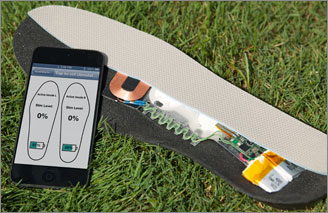https://wyss.harvard.edu/study-shows-vibrating-insoles-could-reduce-falls-among-seniors/
Boston researchers find vibratory stimulation applied to the sole of the foot using novel piezoelectric technology shows promise for fall prevention
(BOSTON) — Findings
published today in the Archives of Physical Medicine and Rehabilitation
show that imperceptible vibratory stimulation applied to the soles of
the feet improved balance by reducing postural sway and gait variability
in elderly study participants. The vibratory stimulation is delivered
by a urethane foam insole with embedded piezoelectric actuators, which
generates the mechanical stimulation. The study was conducted by
researchers from the Institute for Aging Research (IFAR) at Hebrew
SeniorLife, Beth Israel Deaconess Medical Center, the Wyss Institute for
Biologically Inspired Engineering at Harvard University, and Harvard
Medical School, all of Boston, Massachusetts; and Merck Sharpe and Dohme
(MSD) Consumer Care, Inc., of Memphis, Tennessee.
- These findings are significant because poor balance and an
irregular gait are directly related to fall risk. Falls are the leading
cause of death from injury among seniors. Risk increases with age and
even the fear of falling can reduce quality of life.
- 1 in 3 seniors falls each year, and 25% of those who fall suffer moderate to severe injuries, such as hip fractures.
- Only 25% of hip fracture patients make a full recovery; 40% require nursing home care; and nearly 25% die within 12 months.
- By 2020, the annual direct and indirect cost of fall injuries is expected to reach nearly $55 billion.

Earlier studies by Wyss Institute Core Faculty member James Collins, Ph.D., a Professor of Medicine and Biomedical Engineering at Boston University, have shown that imperceptible vibratory noise applied to the feet can improve balance in healthy young and elderly subjects and patients with diabetic neuropathy and stroke. IFAR researchers showed that this approach could significantly reduce the stride-, stance- and swing-time variability exhibited in walking by elderly people with a history of falling down. However the devices that delivered the stimulation in the earlier IFAR studies required large energy sources, limiting their practical and portable application.
Following the experiments with these limiting early devices, the device was completely redesigned by Wyss Institute researchers to use piezoelectric actuators to improve portability and energy efficiency. Piezoelectric actuators convert electrical energy into mechanical signals, such as pressure or movement of some kind. These actuators, inserted into a typical insole using a standard manufacturing process, are driven by a small encasement on the tongue of the shoe that contains a tiny circuit and rechargeable battery.
The vibrating insole study enrolled 12 elderly volunteers in good health, between the ages of 65 and 90 years old. Two piezoelectric actuators to deliver the vibratory stimulation were placed in the medial arch region of commonly-available insoles. Then, participants underwent a battery of tests that measured their balance and assessed their gait. They were also given a timed “Get Up and Go” test, which measured how long it took participants to stand up from sitting, walk three meters, turn around, walk back, and sit down again.
Results of this study demonstrated that the vibratory insoles significantly improved performance on the timed “Get Up and Go” test, reduced the range of postural sway, and reduced the variability of walking. Also, the effect of the insoles persisted throughout the course of a day.
This study was supported by Merck Sharpe and Dohme (MSD) Consumer Care, Inc., Memphis, Tennessee, the National Institute on Aging, Bethesda, Maryland, and the Wyss Institute for Biologically Inspired Engineering at Harvard University, Boston, Massachusetts.
No comments:
Post a Comment